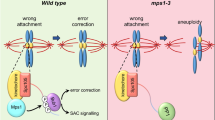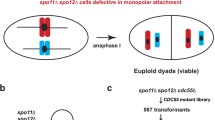Abstract
The accurate segregation of sister chromatids at the metaphase to anaphase transition in Saccharomyces cerevisiae is regulated by the activity of the anaphase-promoting complex or cyclosome (APC/C). In the event of spindle damage or monopolar spindle attachment, the spindle checkpoint is activated and inhibits APC/C activity towards the anaphase inhibitor Pds1p, resulting in a cell cycle arrest at metaphase. We have identified a novel allele of a gene for an APC/C subunit, cdc16-183 , in S. cerevisiae. cdc16-183 mutants arrest at metaphase at 37°C, and are supersensitive to the spindle-damaging agent nocodazole, which activates the spindle checkpoint, at lower temperatures. This supersensitivity to nocodazole cannot be explained by impairment of the spindle checkpoint pathway, as cells respond normally to spindle damage with a stable metaphase arrest and high levels of Pds1p. Despite showing metaphase arrest at G2/M at 37°C, cdc16-183 mutants are able to perform tested G1 functions normally at this temperature. This is the first demonstration that a mutation in a core APC/C subunit can result in a MAD2-dependent arrest at the restrictive temperature. Our results suggest that the cdc16-183 mutant may have a novel APC/C defect(s) that mimics or activates the spindle checkpoint pathway.







Similar content being viewed by others
References
Alexandru G, Zachariae W, Schleiffer A, Nasmyth K (1999) Sister chromatid separation and chromosome re-duplication are regulated by different mechanisms in response to spindle damage. EMBO J 18:2707–21
Amon A (1997) Regulation of B-type cyclin proteolysis by Cdc28-associated kinases in budding yeast. EMBO J 16:2693–2702
Amon A, Tyers M, Futcher B, Nasmyth K (1993) Mechanisms that help the yeast cell cycle clock tick: G2 cyclins transcriptionally activate G2 cyclins and repress G1 cyclins. Cell 74:993–1007
Amon A, Irniger S, Nasmyth K (1994) Closing the cell cycle circle in yeast: G2 cyclin proteolysis initiated at mitosis persists until the activation of G1 cyclins in the next cycle. Cell 74:993–1007
Chen RH, Brady DM, Smith D, Murray AW, Hardwick KG (1999) The spindle checkpoint of budding yeast depends on a tight complex between the Mad1 and Mad2 proteins. Mol Biol Cell 10:2607–2618
Cohen-Fix O, Peters JM, Kirschner MW, Koshland D (1996) Anaphase initiation in Saccharomyces cerevisiae is controlled by the APC-dependent degradation of the anaphase inhibitor Pds1p. Genes Dev 10:3081–3893
Fang G, Yu H, Kirschner MW (1998a) Direct binding of CDC20 protein family members activates the anaphase-promoting complex in mitosis and G1. Mol Cell 2:163–171
Fang G, Yu H, Kirschner MW (1998b) The checkpoint protein MAD2 and the mitotic regulator CDC20 form a ternary complex with the anaphase-promoting complex to control anaphase initiation. Genes Dev 12:1871–1883
Fraschini R, Formenti E (1999) Budding yeast Bub2 is localized at spindle pole bodies and activates the mitotic checkpoint via a different pathway from Mad2. J Cell Biol 145:979–991
Gerring SL, Spencer F, Hieter P (1990) The CHL1 ( CTF1) gene product of Saccharomyces cerevisiae is important for chromosome transmission and normal cell cycle progression in G2/M. EMBO J 9:4347–4358
Guthrie C, Fink G (1991) Guide to yeast genetics and molecular biology. Academic Press, San Diego
Hardwick K, Li R, Mistrot C, Chen RC, Dann P, Rudner A, Murray AW (1999) Lesions in many different spindle components activate the spindle checkpoint in the budding yeast Saccharomyces cerevisiae. Genetics 152:509–518
Hardwick KG, Weiss E, Luca FC, Winey M, Murray AW (1996) Activation of the budding yeast spindle assembly checkpoint without mitotic spindle disruption. Science 273:953–956
Hardwick KG, Johnston RC, Smith DL, Murray AW (2000) MAD3 encodes a novel component of the spindle checkpoint which interacts with Bub3p, Cdc20p, and Mad2p. J Cell Biol 148:871–872
Hilioti Z, Chung YS, Mochizuki Y, Hardy CFJ, Cohen-Fix O (2001) The anaphase inhibitor Pds1 binds to the APC/C-associated protein Cdc20 in a destruction box-dependent manner. Curr Biol 11:1347–1352
Hoyt MA, Trotis L, Roberts BT (1991) S. cerevisiae genes required for cell cycle arrest in response to loss of microtubule function. Cell 66:501–517
Huffaker TC, Thomas JH, Botstein D (1988) Diverse effects of β-tubulin mutations on microtubule formation and function. J Cell Biol 106:1997–2010
Hwang LH, Lau LF, Smith DL, Mistrot CA, Hardwick KG, Hwang ES, Amon A, Murray AW (1998) Budding yeast CDC20: a target of the spindle checkpoint. Science 279:1041–1045
Irniger S, Piatti S (1995) Genes involved in sister chromatid separation are needed for B-type cyclin proteolysis in budding yeast. Cell 81:269–278
Irniger S, Piatti S, Michaelis C, Nasmyth K (1997) The anaphase-promoting complex is required in G1 arrested yeast cells to inhibit B-type cyclin accumulation and to prevent uncontrolled entry into S-phase. J Cell Sci 110:1523–1531
Lamb JR, Michaud WA, Sikorski, RS, Hieter PA (1994) Cdc16p, Cdc23p and Cdc27p form a complex essential for mitosis. EMBO J 13:4321–4328
Li R, Murray AW (1991) Feedback control of mitosis in budding yeast. Cell 66:519–531
Lim HH, Goh PY, Surana U (1998) Cdc20 is essential for the cyclosome-mediated proteolysis of both Pds1 and Clb2 during M phase in budding yeast. Curr Biol 8:231–234
Nasmyth K (2001) Disseminating the genome: joining, resolving, and separating sister chromatids during mitosis and meiosis. Annu Rev Genet 35:673–745
Reimann JR, Gardner BE, Margottin-Goguet F, Jackson PK (2001) Emi1 regulates the anaphase-promoting complex by a different mechanism than Mad2 proteins. Genes Dev 15:3278–3285
Rudner AD, Murray AW (2000) Phosphorylation by Cdc28 activates the Cdc20-dependent activity of the anaphase-promoting complex. J Cell Biol 149:1377–1390
Schott EJ, Hoyt MA (1998) Dominant alleles of Saccharomyces cerevisiae CDC20 reveal its role in promoting anaphase. Genetics 148:599–610
Schutz AR, Winey M (1998) New alleles of the yeast MPS1 gene reveal multiple requirements in spindle pole body duplication. Mol Biol Cell 9:759–774
Schwab M, Lutum AS, Seufert W (1997) Yeast Hct1 is a regulator of Clb2 cyclin proteolysis. Cell 90:683–693
Shirayama M, Toth A, Galova M, Nasmyth K (1999) APC(Cdc20) promotes exit from mitosis by destroying the anaphase inhibitor Pds1 and cyclin Clb5. Nature 402:203–207
Sikorski RS, Boeke JD (1991) In vitro mutagenesis and plasmid shuffling: from cloned gene to mutant yeast. Methods Enzymol 194:302–318
Surana U, Robitsch H, Price C, Schuster T, Fitch I, Futcher AB, Nasmyth K (1991) The role of CDC28 and cyclins during mitosis in the budding yeast S. cerevisiae. Cell 65:145–161
Visintin R, Prinz S, Amon A (1997) CDC20 and CDH1: a family of substrate-specific activators of APC-dependent proteolysis. Science 278:460–463
Wang Y, Burke DJ (1995) Checkpoint genes required to delay cell division in response to nocodazole respond to impaired kinetochore function in the yeast Saccharomyces cerevisiae. Mol Cell Biol 15:6838–6844
Weiss E, Winey M (1996) The Saccharomyces cerevisiae spindle pole body duplication gene MPS1 is part of a mitotic checkpoint. J Cell Biol 132:111–123
Yamamoto A, Guacci V, Koshland D (1996) Pds1p, an inhibitor of anaphase in budding yeast, plays a critical role in the APC and checkpoint pathway(s). J Cell Biol 133:99–110
Yu H (2002) Regulation of APC-Cdc20 by the spindle checkpoint. Curr Opin Cell Biol 14:706–714
Zachariae W, Nasmyth K (1999) Whose end is destruction: cell division and the anaphase-promoting complex. Genes Dev 13, 2039–2058
Zhang Y, Lees E (2001) Identification of an overlapping binding domain on CDC20 for Mad2 and the anaphase-promoting complex: model for spindle checkpoint regulation. Mol Cell Biol 21:5190–5199
Acknowledgements
We would like to thank Phil Hieter, Doug Koshland, Orna Cohen-Fix, Forrest Spencer, Tim Huffaker, Ted Weinert, Mark Winey, and Vincent Guacci for their contributions of strains, plasmids, and antibodies. We thank the members of the Holloway lab and the Department of Genetics for helpful discussion, and David Dicker for performing flow cytometry. This research was supported by the Howard Hughes Medical Institute
Author information
Authors and Affiliations
Corresponding author
Additional information
Communicated by C. P. Hollenberg
Rights and permissions
About this article
Cite this article
Lai, L.A., Morabito, L. & Holloway, S.L. A novel yeast mutant that is defective in regulation of the Anaphase-Promoting Complex by the spindle damage checkpoint. Mol Genet Genomics 270, 156–164 (2003). https://doi.org/10.1007/s00438-003-0912-5
Received:
Accepted:
Published:
Issue Date:
DOI: https://doi.org/10.1007/s00438-003-0912-5




